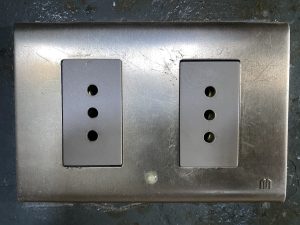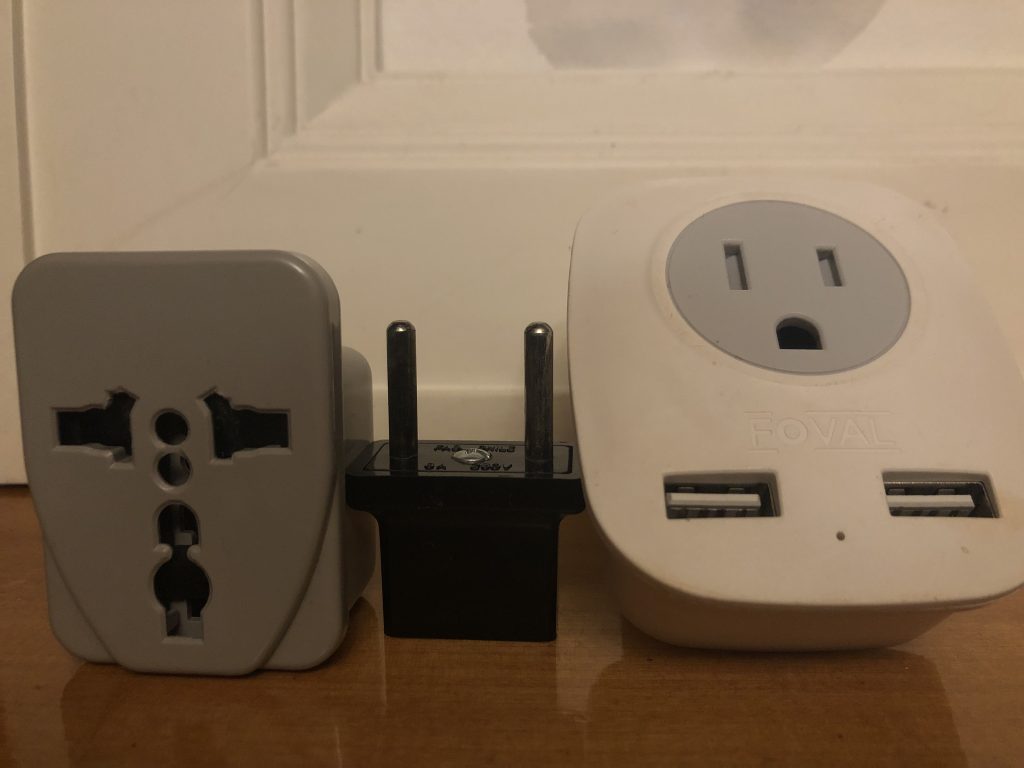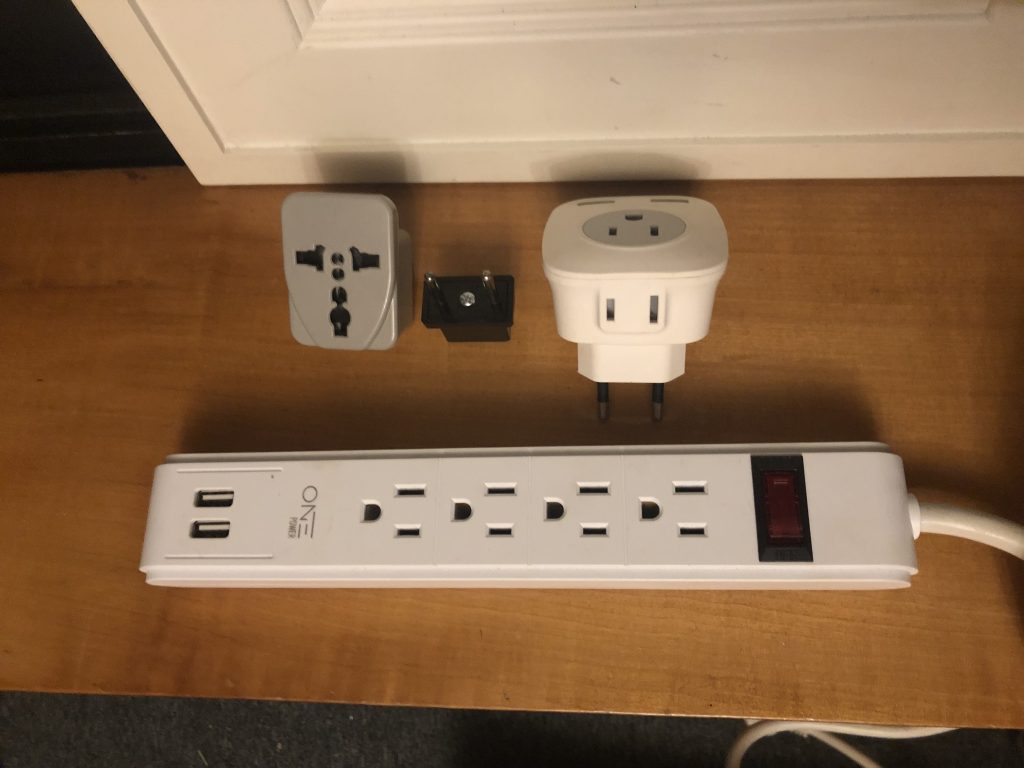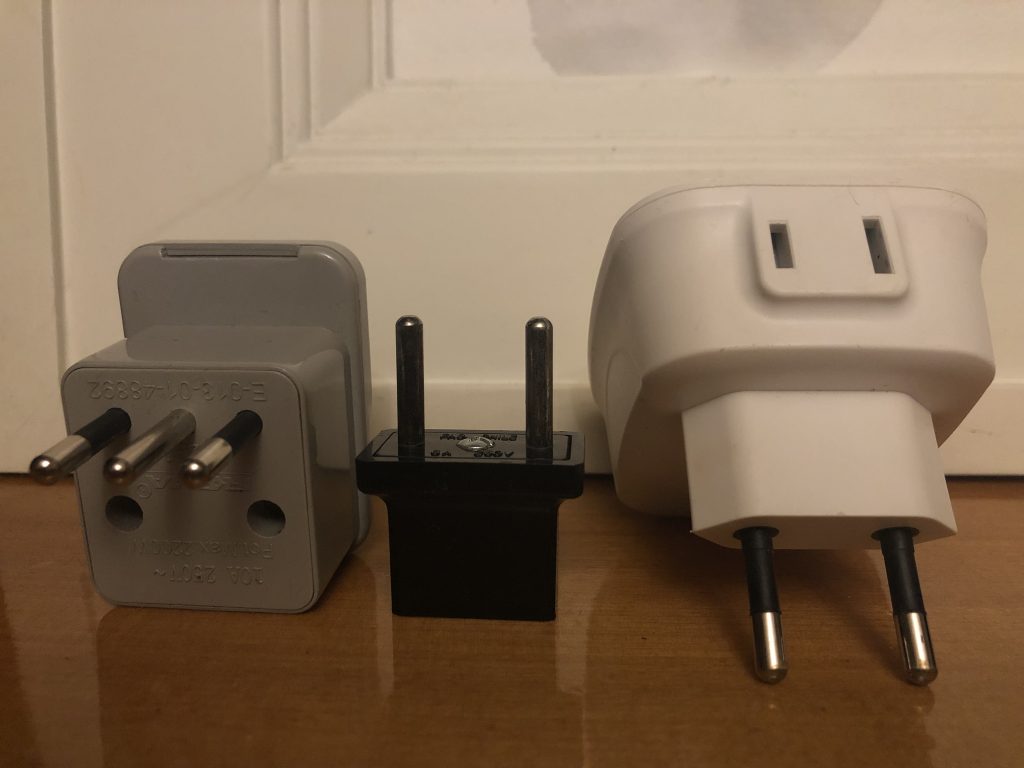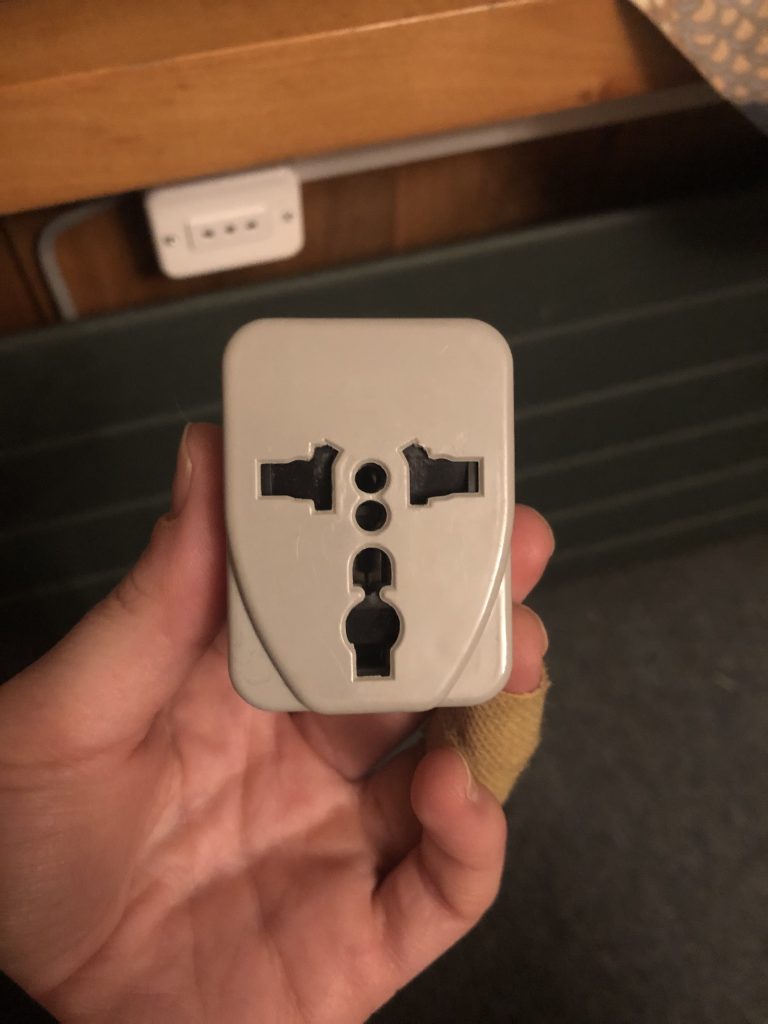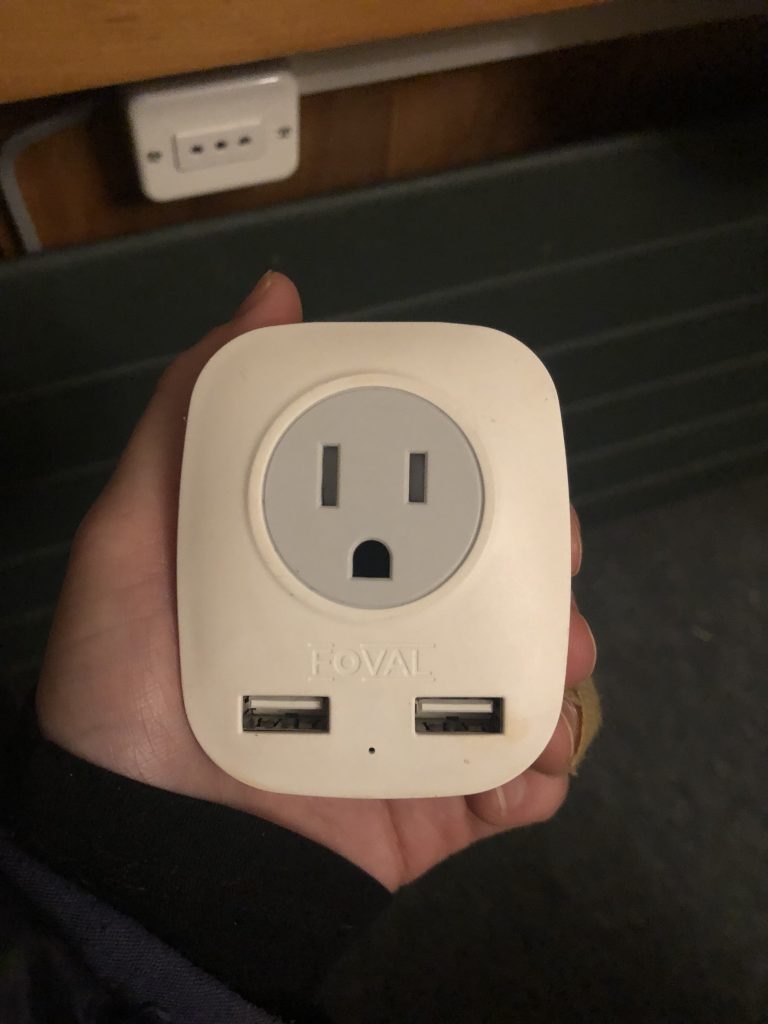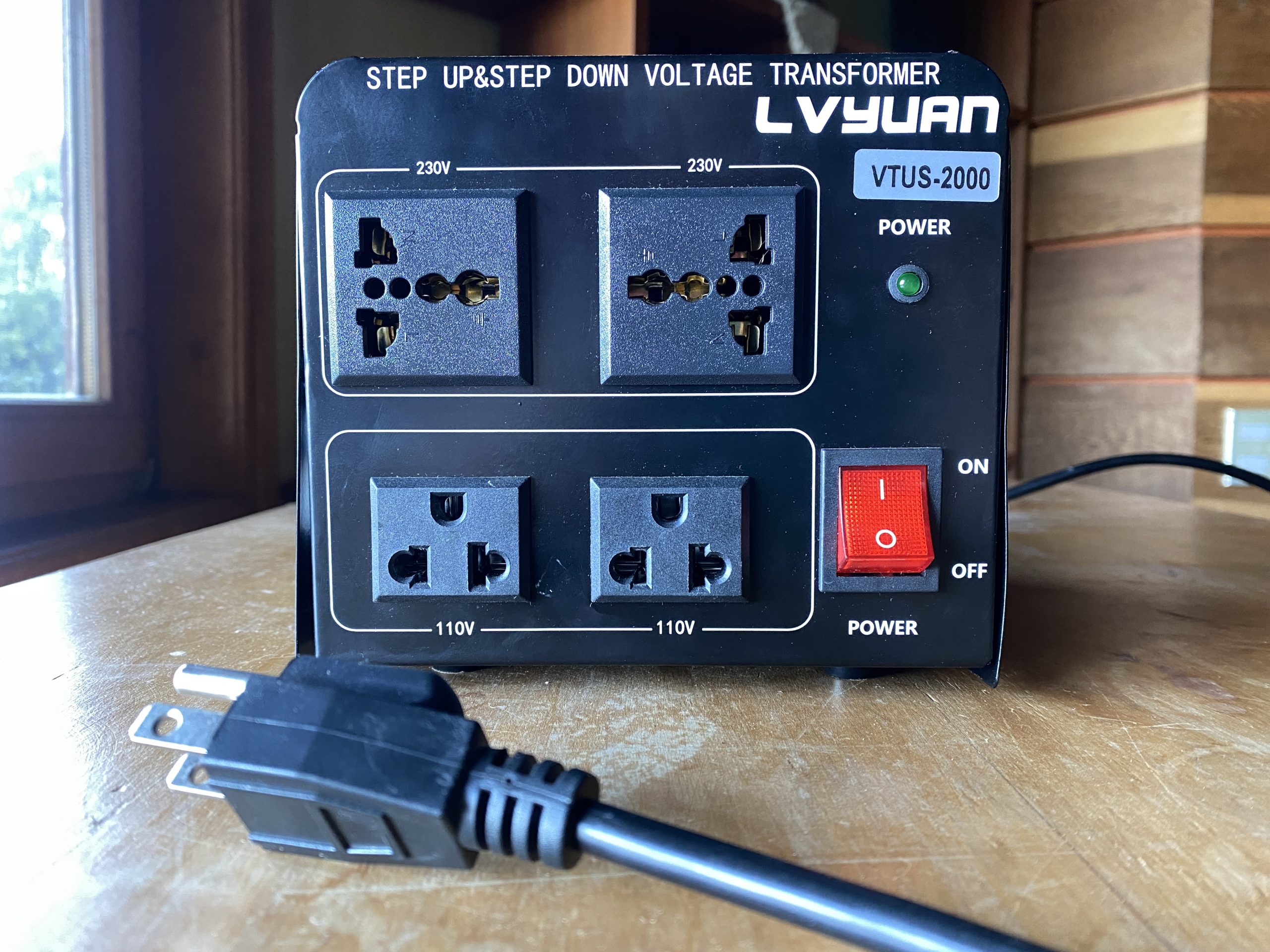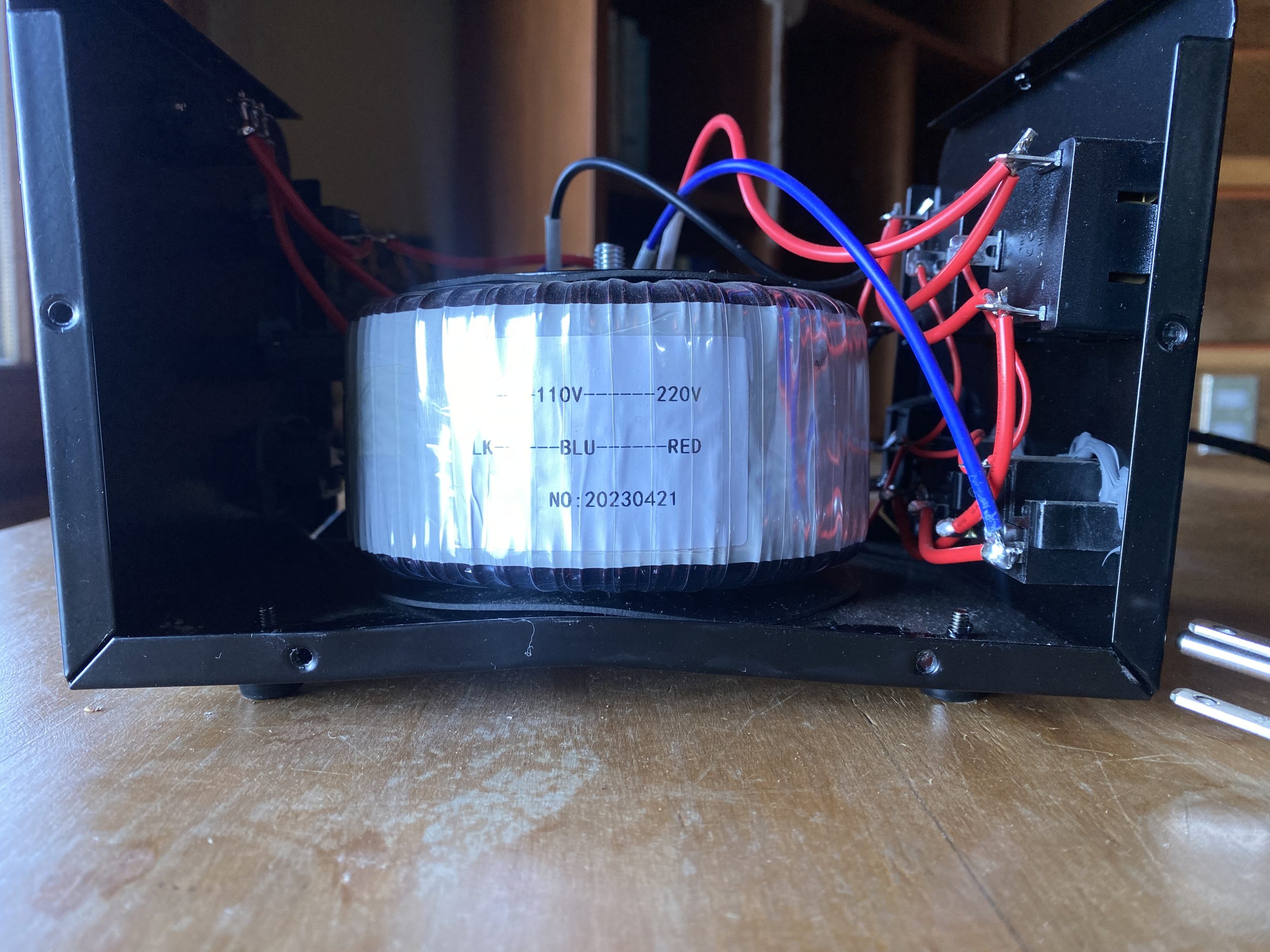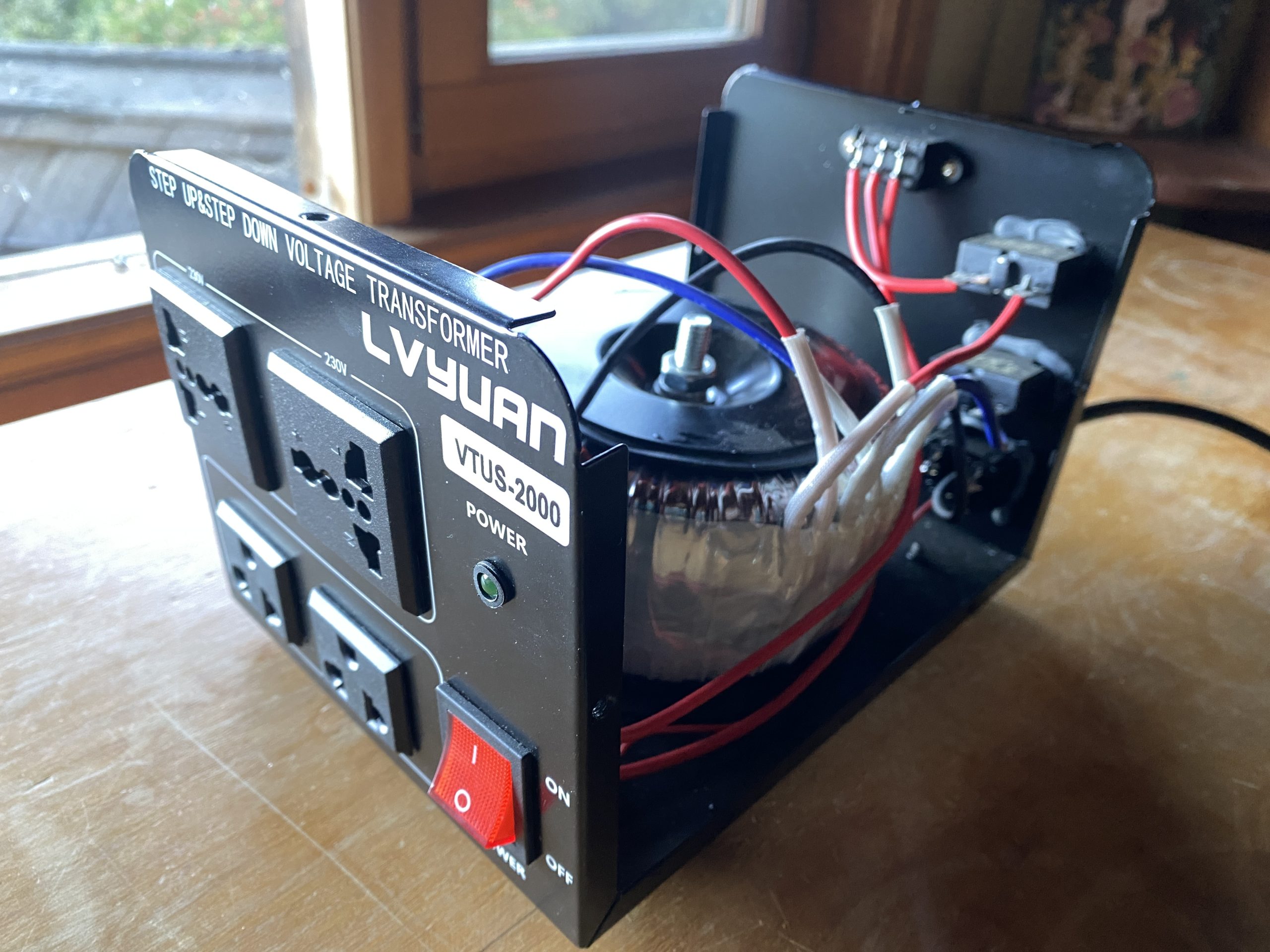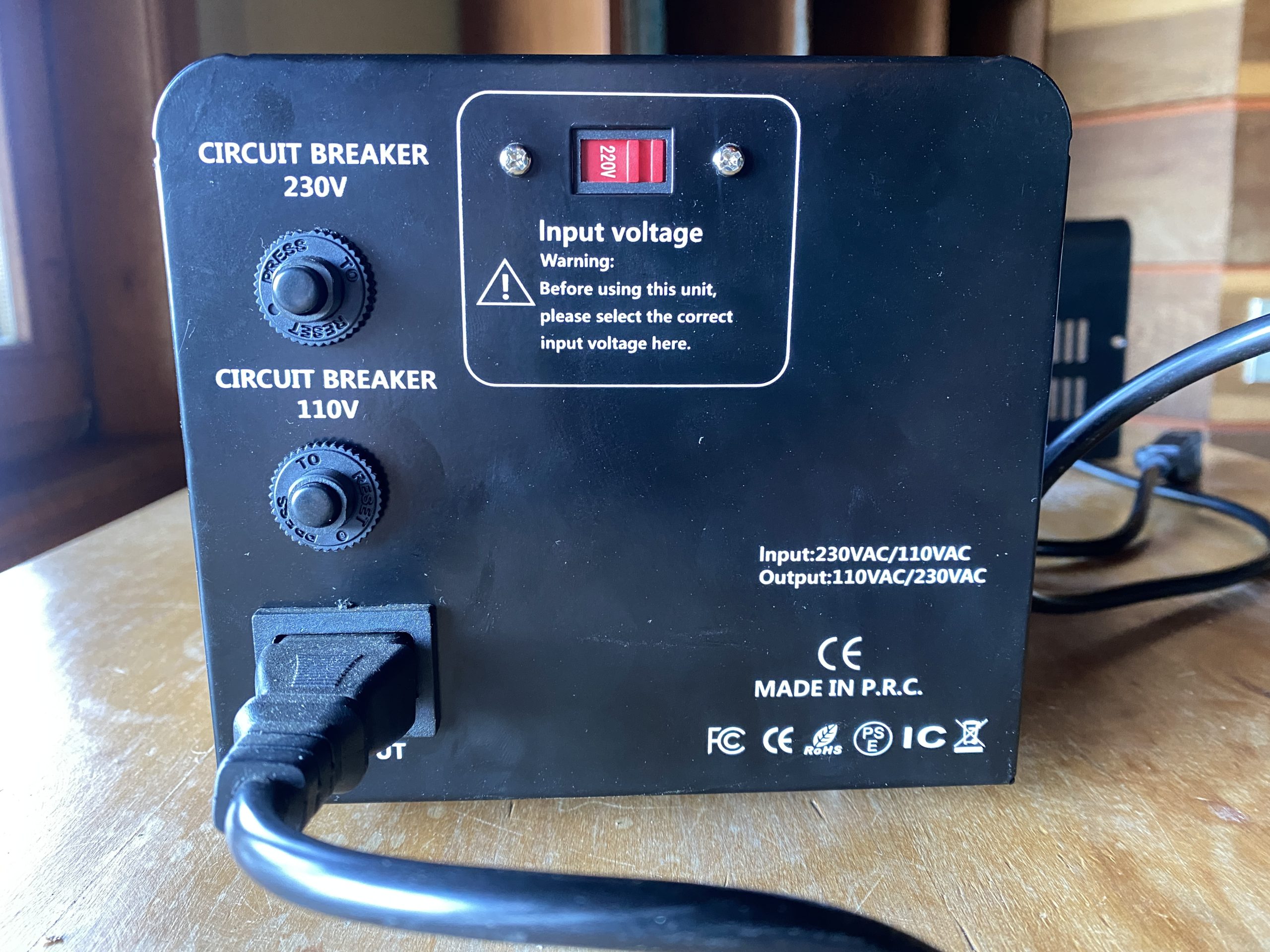Power Outlets and Voltage in Chile: Best Travel Adapters
Disclosure: This article contains affiliate links, meaning that when you purchase through qualifying links, we earn a commission at no additional cost to you. We highlight products and services that we’ve researched and/or used and that we find truly helpful! For more information, see the Disclosure Policy.
Not Sure About Plug Types, Power Outlets, and Voltage Supply Used in Chile?
As you jot down your I’m-going-to-Chile packing list, you’re probably wondering: Do I need a plug adapter or voltage converter for Chile? The answer is (probably) yes to the adapter… and (probably) no to the converter.
As a U.S. American living in Chile since 2014, I’ve experienced a few overvoltage surges on electronic devices that I’ve brought back with me from the U.S. (so much for my new vacuum).
But as long as you’re not planning to travel with large household appliances, you should be fine since most travel-sized electronics are dual-voltage (more on that below).
Use this Guide to Power Outlets and Voltage in Chile to keep your electronics safe and usable while traveling!
In this article, we cover the voltage level and plug/ outlet types used in Chile, as well as the different kinds of plug adapters we like to use.
The Short Answer: Standard Voltage, Plugs, and Outlet Types in Chile
The Standard Voltage used in Chile is 220-240V — that’s double North and Central America’s standard voltage, but the same as in Europe, Australia, and most of the world.
The Standard Frequency used in Chile is 50Hz — the same as most of the world, but in North and Central America, it’s 60Hz.
The Standard Plug Types and Power Outlets used in Chile are:
- Type-C unearthed = 2 round pins (4mm diameter)
- Type-L earthed = 3 round pins or holes (4mm diameter)
Adapter vs. Converter
An Adapter (aka plug adapter or power adapter) is used to adapt the physical shape of the plug so that it can be plugged into a different type of power outlet or socket. It doesn’t transform the voltage of the power source.
A Converter (aka voltage converter, voltage transformer, or voltage adapter) transforms the voltage level of the power source to accommodate your device.


The type-C plug (2 prongs) is the most common in Chile. Type-L plugs (3-prongs) are used with larger, more powerful appliances, but in order to accommodate both plug types... most wall outlets in Chile are type-L (3 holes) .
Important Note:
Type-C plugs and outlets are common in several European countries, but Italy is the only country outside Chile that uses type-L plugs and outlets.
The type-C outlets conveniently have holes large enough to receive type-E and type-F plugs (4.8mm), which are also commonly used in Europe.
In Chile, the outlets have 4mm holes, so the type-E and type-F plugs won’t fit. If you’re coming from Europe with E or F plugs and you read that “type-C” is standard in Chile, don’t be deceived.
It’s true, of course, that type-C plugs are standard, but I’ve rarely seen a C outlet in Chile.
The Bottom Line
1. If your electronics are dual voltage, you won’t need a voltage converter.
Most of the devices people travel with are dual voltage and are totally fine to plug in anywhere. Jump below for a list of electronics that are typically dual voltage.
Travelers from North, Central, and South America and Japan may want a voltage converter in Chile for single-voltage devices designed to work only at 100-127 volts.
If you do opt to bring a voltage converter, be careful! We go in-depth about this here.
2. If your electronics don’t have type-C or type-L plugs, you will need a travel adapter.
Travelers from North America, Australia and New Zealand, the UK and Ireland, and several other countries will need a power plug adaptor in Chile.
Travelers using devices with 4mm type-C plugs (parts of Europe) or type-L plugs (Italy) do not need a power plug adapter in Chile.
Click here to find the plug and outlet types used in your country.
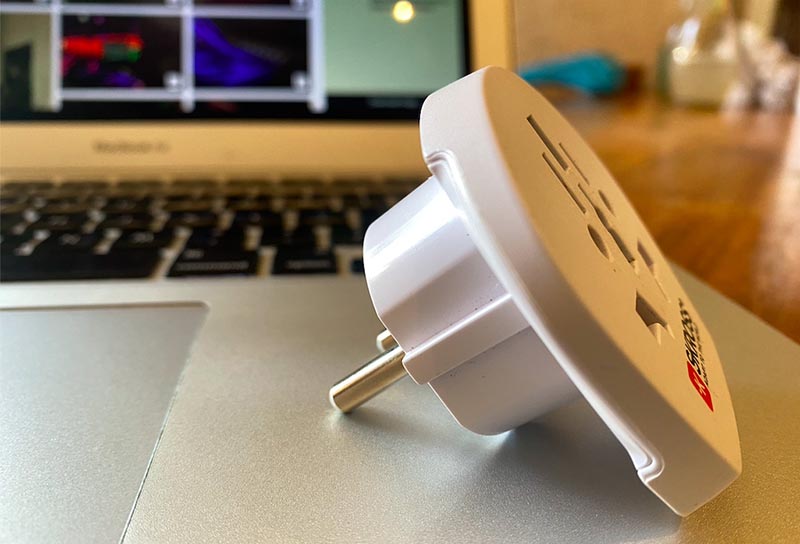
Our Favorite Travel Adapters for Chile
If you’re visiting Chile from Europe, it’s possible that you won’t need to pack a power adaptor, just make sure the plugs on your electronic devices use the 4mm type-C or type-L rounded prongs.
It’s worth it to note that many type-C power outlets in Europe actually have 4.8mm holes, making them more versatile since they can accept the type-C plugs as well as the bigger 4.8mm type-E and type-F plugs, which are also common in Europe.
We had a lovely group of travelers from Europe stay with us who ran into this problem: their devices had 4.8mm prongs… and while the outlets at one of their previous lodgings happened to be large enough, our typical type-L outlets were not. Luckily, we had plenty of adapters to pass around.
The guideline is: If you’re visiting Chile from anywhere that doesn’t use 4mm type-C or type-L plugs, you will want a power adapter.
Many travel adapters designed for travel in Europe also work in Chile, and it’s often easier to find adapters advertised as “for Europe” than it is to find adapters advertised as “for Chile.”
Just make sure, once again, that the adapter uses 4mm prongs. Some “world-to-Europe” adapters (like the one in the picture above) take for granted that many European outlets have bigger holes.
A quick reference for plug types:
- U.S., Canada, Mexico, and Japan use type-A and B.
- The U.K. and Ireland use type-G.
- Australia, New Zealand, and China use type-I.
Click here to find the plug and outlet types used in your country.
We’ve used all sorts of different types of travel adapters over the years, and these are our favorites:
1. Power Strip Adapter
The power strip style of adapter (aka travel power strip, aka travel adapter with extension cord) is my number one pick for a few reasons:
- The plug part isn’t bulky. This makes it easier to plug the strip into hard-to-reach spaces, like wall outlets hidden behind furniture.
- This kind of adapter comes with a cord, which means you can use your device as it charges, even sitting a fair distance away from the outlet.
- The power strip adapter has multiple ports, which means you can charge multiple devices at once! Even if you only have access to one wall outlet.
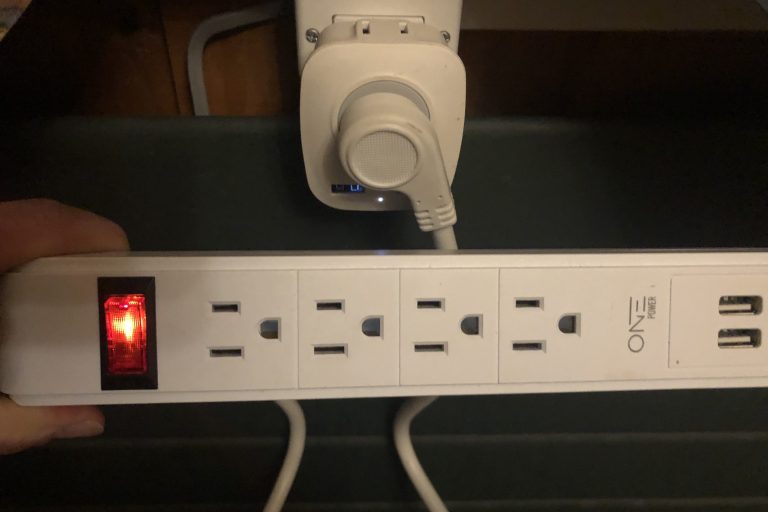
** Our Family Travel Hack** If you take a second glance at the picture above, you’ll see that we used a U.S.-made powerstrip from home — like this one or this one with USB ports — and simply attached a grounded plug adapter (see below) and voilà.
Just make sure the power strip itself is dual-voltage or can handle up to 250V.
And be careful not to overload the adapter; it should be designed to handle the amount of amps/watts that your devices consume. Charging a laptop, a cellphone, and a digital camera at the same time is no problem, but bigger devices, like a space heater, may overload the strip.
Here’s what to look for in a travel power strip adapter:
Important: An adapter is not a converter. The adapter may be able to handle up to 240V, but it can’t convert a 240-voltage supply down to 120 to accommodate a single-voltage device.
There are travel strip adapters with “built-in voltage converters,” but we go into detail on why we don’t recommend them below.
Many travel power strip adapter kits (like the Beeiker one above) or this Kakyanill model are intentionally designed to work with adapter attachments: the cable itself has one inbuilt plug type, and the kit comes with several simple plug attachments that you can swap out from one country to the next.
2. Simple Plug Adapter
It’s always helpful to have a few simple plug adapters on hand. You can slip these compact adapters into your pocket when you’re out and about with just your cell phone.
There are three different kinds: simple 1:1 ungrounded, simple 1:1 grounded, and simple universal:1.
Here you can see our (black) simple ungrounded adapter — my mom loves to pop this onto her flat iron — and two versions of the simple grounded adapter. The grey style has been around for years, and if you forget to bring an adapter, you can easily find one in Chile.
But, we like the white adapter with built-in USB ports for a little extra charging capability.
We didn’t include a photo of our universal:1 adapter here because *sigh* the prongs turned out to be too big at 4.8mm (see the earlier photo above).
I’ll level with you: I (Chantel) have lived in Chile long enough at this point that I’m not using adapters in my day-to-day life.
The only electronics I brought with me from the U.S. that I still use daily are my iPhone and my MacBook. And, for those, I prefer the non-bulky inserts from the Apple World Travel Adapter Kit.
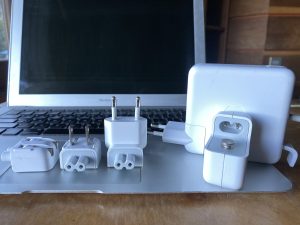
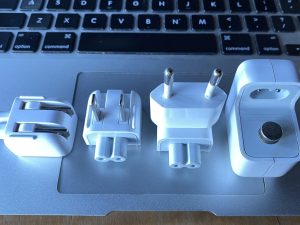
My mom, on the other hand, gets great use out of all of these adapters when she visits for a few months each year.
The Simple 1:1 Ungrounded Adapter
This slim adapter works for small plugs that don’t use a grounding pin.
Here’s what to look for in a simple 1:1 ungrounded adapter:
**Family Travel Hack** Get a couple of USB-A charging blocks with a type-C plug (see below). Any USB-A charging cord (cellphone, digital camera, eReader, etc.) can be plugged into one of these to use in Chile.
Also, you can easily find type-C USB blocks and simple ungrounded adapters in Chile, as well as chargers compatible with iPhone, with micro-USB ports, and with USB-C ports.
Second: The Simple 1:1 Grounded Adapter
This slightly bulkier adapter works for larger devices with a grounding prong/pin. Some U.S. laptop chargers, for example, have a grounding pin. The output plug should be type-C or type-L for Chile, and the input AC port should be compatible with your country’s grounded (3-pin) plug type.
In North America, that’s type-B with a round pin below the two flat blades.
Some adapters (like this one below) even have a few USB ports.
Here’s what to look for in a 1:1 grounded adapter:
Third: The Simple Universal:1 Travel Adapter
This universal-to-Chile (aka World-to-Europe) adapter is also slightly bulkier. It has a type-C plug (or plug attachment in some cases) and a universal port, meaning it will receive almost any plug type.
This type of adapter is nice if you’re planning to travel with international friends and want to share. And hotels often keep them on hand since their guests can come from anywhere.
Here’s what to look for in a universal:1 grounded adapter:
3. Universal Travel Adapter
Universal travel adapters are a great investment for globe trotters, but they’re my least favorite because they’re the most cumbersome.
Still, if you’re planning to travel around South America (or the world!) a universal travel adapter will be worth it for you.
These adapters have universal ports to accept all devices, and they have all the different plug types built-in (or they come with all the different plug types as attachments).
Traditional Universal Travel Adapter
Universal Travel Adapter Kit
These swappable kits are another option for globe trotters.
Voltage in Chile and Dual-Voltage Devices
Voltage in Chile — 220-240V
Chile’s standard voltage (the amount of power coming out of the wall socket) is 220-240V. This is the standard all over Chile, from Antofagasta to Easter Island to Punta Arenas.
Most countries around the world also use a 220-240 supply voltage. But Japan operates at 100V and the U.S. and Canada use a supply voltage of 110-120V, and it’s 127V in Mexico, about half the voltage supply used in Chile.
Voltage is like the “force” that pushes electricity through the circuits (kind of like water flowing through a pipe).
In practical terms, this means that plugging a device designed to work at 110-120V into a power outlet (wall socket) supplying 220-240V is like giving your device a double dose of power.
This will cause a power surge and overload your device! You could see some sparks. And, your device could be permanently damaged.
The reverse scenario is less dangerous… if you plug a 220V device into a 120V wall socket… the device will work at a reduced capacity or probably not work at all.
So, if you’re visiting Chile from the U.S., Canada, Mexico, or Japan, you might want to pack a voltage converter to protect your electronic devices. However, there is a catch…
Most electronics that people travel with are dual-voltage, which means they have no problem operating at different voltages.


Dual Voltage Devices
If your device is dual-voltage, it’s safe to pop on an adapter and plug straight into the wall anywhere in the world without a voltage converter. “Dual” means the device works with a voltage supply of 110-120V and 220-240V (and anywhere in between).
The good news is that many (if not most) of the electronics you plan to travel with are dual-voltage (but you should still double-check before plugging in).
Here’s a List of Electronic Devices that Are Typically Dual-voltage:
- Cell phones (and cell phone chargers)
- Laptop computers (and laptop chargers)
- Digital cameras (and camera battery chargers)
- Tablets and e-readers (and their chargers)
- Portable speakers
- Portable kettles and coffee-makers
- Some hygiene devices like electric toothbrushes and electric trimmers/shavers.
Here’s a List of Electronic Devices that Are Often Not Dual-voltage:
- Hair dryers
- Hair straighteners and curling irons (especially older models)
- Household appliances
- Power tools
- Heating and cooling devices
- Desktop computers
Are Travel Voltage Converters Even Worth It?

Of course, you most likely won’t be traveling with household appliances or a desktop computer. And, some newer hairdryers, flat irons, and curling irons are made with dual-voltage capabilities. (Although my sister’s Dyson Airwrap wasn’t).
So, if you’re not moving to Chile (and bringing an all-in-one vacuum-mop that you could only find in the U.S.), you should be fine without a voltage converter.
It’s important to note one more time (or in case you jumped to this section) that a travel adaptor — the thing that adapts plug shapes — is NOT a voltage converter (unless it specifically says so).
Example: if you use a travel adaptor to plug your US-made 120V hairdryer into a 220V Chilean wall socket, the power adaptor will be fine, but the hairdryer won’t.
Even though many electronics are dual-voltage, it’s best to check the label or device manual before packing it. Or look for an indicator that says: 100-240V, 50-60Hz.
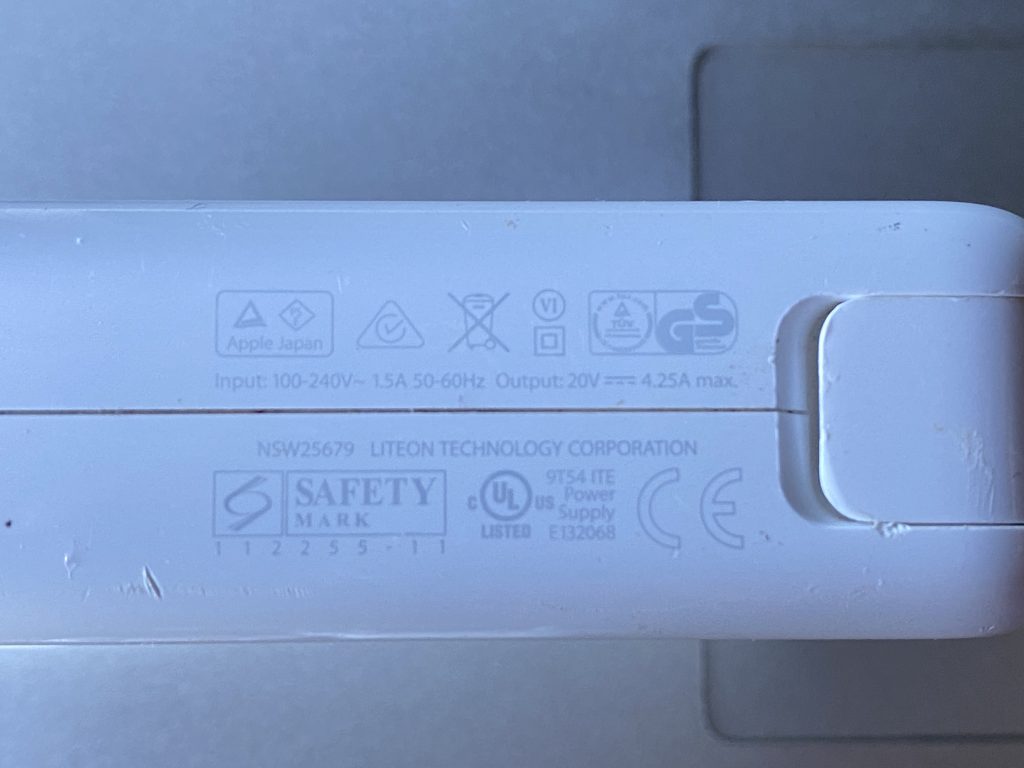
A power converter (AKA voltage converter or voltage transformer) will actually transform the electricity’s voltage supply to suit your device.
- Step-down converters can take a 240-voltage supply and step it down to around 110-120 volts.
- Step-up converters transform a 110-voltage supply up to 240 volts.
- Step-up/down converters can go both ways.
With converters, it’s also important to check how many amps/watts the converter can handle. And, powerful, well-made converters are usually big and heavy!
Beware of “Built-in” Voltage Converters.
Shopping online, I’ve come across some travel adapter power strips that claim to have a built-in voltage converter; some even claim to power up to 2000 watts. But, they are so slim and compact, I’m left wondering: Where’s the motor?
The reviews are telling. The 4 and 5-star reviews say that the voltage converter works wonderfully… but then go on to say that they were able to charge a laptop or cellphone just fine. There’s the catch.
Laptops and cellphones are dual voltage: those devices didn’t need a voltage converter in the first place. So, the “built-in” voltage converter did nothing.
As I move on to the 1 and 2-star reviews, I start to find stories of overheated hair dryers and blown fuses.
So my take is that a travel-sized voltage converter is not worth it.
If you absolutely need to blow dry your hair in Chile, most hotels and rentals have hairdryers, and you can easily buy one in Chile for around $12USD or $10,000 CLP (which you could use again next time you’re in Europe). Or bring a dual-voltage travel hair dryer.
If you have a specialty device (like a Dyson Airwrap) that you simply cannot travel without, invest in a dedicated voltage converter that supports the amps/watts that your device uses to operate. And read the reviews!
Also, don’t even worry about the plug type that the voltage converter has. If it’s a good converter, you can just pop on a simple plug adapter and use it anywhere.
Here’s a picture of my step-up/step-down voltage converter. It can take 230V down to 110V and vice versa, and it’s able to handle 2000-watt devices. I’ve tested it with a steam machine and vacuum cleaner that I brought from the U.S. (Yes, my hubby fixed my vacuum cleaner for me).
You can see that my converter is big and heavy (it weighs 10 lbs./ 4.5 kg) and has a big motor. I bought it here (the brand name has changed from Lvyuan to Yinleader). If you’re looking for something slightly slimmer, I found this one with positive reviews, but it’s actually heavier at almost 15 lbs., and it’s only a step-down converter.
Frequency in Chile — 50Hz — (and Why It Matters Less than Voltage)
Psst… you can skip this section. But, in case you’re curious, here it is:
The frequency, measured in Hertz (Hz), refers to the number of cycles per second in the AC (alternating current) power supply. The two most commonly used frequencies around the world are 50 or 60Hz.
Chile (and most of the world) supplies power at 50Hz. North America and parts of Central America and the Caribbean use 60Hz.
Too high a frequency can cause electronic devices with motors to run faster (which can lead to overheating if the device isn’t designed for that frequency). Too low a frequency can cause the motor to run more slowly, resulting in a device that won’t operate at full capacity.
Devices with built-in timers are also affected by frequency changes.
That said, the effect of using the wrong frequency is minimal compared to using the wrong voltage — both because the difference between 50 and 60Hz is quite small and because the difference between 120 and 220V is quite large.
Example: Your U.S.-made hairdryer is built to work with 120V at 60Hz. You plug it into a Chilean wall socket supplying 220V at 50Hz. The decrease in hertz (potentially slowing down the motor of your hair dryer) doesn’t even matter because your hairdryer blows out from way too much voltage.
Vice versa: You plug a Chilean-made hairdryer into a U.S. wall socket. The uptick in hertz (potentially causing the motor to speed up) will be outweighed by the fact the dryer is only getting half the amount of voltage needed.
In the end, you don’t need to worry too much about frequency, and if you’re using dual-voltage devices, they are built to handle power supplies at both 50 and 60Hz.
Tips for Using Power Outlets in Chile
1. Check your devices’ plug types and voltage capacity before travel.
For voltage, you can check the back of the device itself; if it’s not listed, check the manual or look it up online. It should say “dual-voltage” or something to the effect of: “100-240V, 50/60Hz.”
2. Invest in a quality power adapter.
Travel Adapter kits are a great investment for frequent travelers, you’ll be able to plug in no matter where you go. And, if it comes with a surge protector, you’ll have all your bases covered.
3. Bring a Battery Pack
Having a battery back is a lifesaver for me, especially for the airport and long bus rides.
We bought ours in Chile. We like that it’s slim, has multiple output cables, and is fast charging, like this one. If we get another one, I’ll probably get something sturdy for the outdoors or honestly, I’d invest in a battery pack to power my laptop (it’s always a bummer for me when I’m working at a cafe and there are no outlets in site).
4. Don’t sweat it.
If you forget to pack an adapter, they have them in Chile too! You can easily pop into an electronics store here and pick one up.

Traveling Around South America?
Here’s a quick reference list of power outlets used in other countries in South America:
Argentina — Type-C and Type-I (most common), some outlets are designed to accept both.
Bolivia — Type-A and Type-C (most common), some outlets are designed to accept both.
Brazil — Type-N (also works with C plugs)
Colombia — Type-A and Type-B
Ecuador — Type-A and Type-B
Guyana — Type-A and B (most common), Type-D, Type-G
Paraguay — Type-C
Peru — Type-A and Type-C (more common), some outlets are designed to accept both.
Suriname — Type-A and B, Type-C, Type-F (most common)
Uruguay — Type-A, Type-C, Type-F, Type-L (most common)
Venezuela — Type-A and B
Frequently Asked Questions
What is the Voltage in Chile vs USA?
The voltage supply in Chile is 220-240V. The voltage supply in the U.S.A. is 110-120V.
What kind of power outlets are used in Chile?
Chile mostly uses type-L outlets. These outlets accommodate type-L plugs and type-C plugs, with 2 or 3 rounded prongs of a 4mm diameter each.
Does Chile use the same electrical outlets as the U.S.?
No, Chile’s electrical outlets are different from the outlets in the U.S. Chile uses type-L plugs with 3 (4mm) holes in a row. The U.S. uses type-A and type-B outlets.
Are Chile plugs the same as Europe’s?
The plugs used in Chile — type-C — are the same as in many European countries (but not the UK, Ireland, Malta, or Cyprus). Chile also uses earthed type-L plugs for larger appliances that require grounding.
Do Chile and Argentina use the same power outlets?
No, most power outlets and plug types in Argentina are type-I (the same as in Australia, New Zealand, and China). However, there are some places in Argentina with type-C power outlets — the plug type used in Chile — or outlets that accommodate both.
Do I need a voltage converter in Chile?
Chile has a 220-240 voltage supply. You will only need a converter if you plan to use an electronic device that is not dual-voltage and not compatible with 220-240V. For example, a non-dual-voltage hair dryer made in the U.S. would be compatible with a 120-voltage supply and would not work in Chile. (It would overheat).
What kind of adapter do I need for Chile?
For travel in Chile, you need a type-C adapter.
It should have a type-C plug to fit into the Chilean power outlet and have a port that accepts the plug type from your country (some are designed to accept any plug type). Note: type-C refers to the plug type common in Europe and Chile, not USB-C.
Does my iPhone need a voltage converter in Chile?
iPhones are dual voltage, meaning they can be charged anywhere in the world (including Chile) without a voltage converter.
What is the voltage in South America?
Argentina, Bolivia, Brazil (most areas), Chile, Guyana, Paraguay, Peru, and Uruguay use a voltage supply of 220-240 volts.
Colombia, Ecuador, Suriname, Venezuela, and some parts of Brazil use a voltage supply of 110-127 volts.
Do I need a special plug for South America?
If you plan to travel around South America, we recommend investing in a universal power plug adapter or kit, as there are many power outlet types throughout South America.


